Discovering Dubai's Unique Gardens and Green Spaces
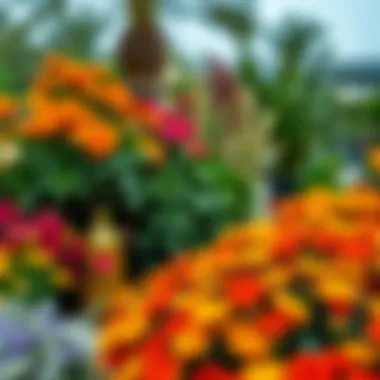
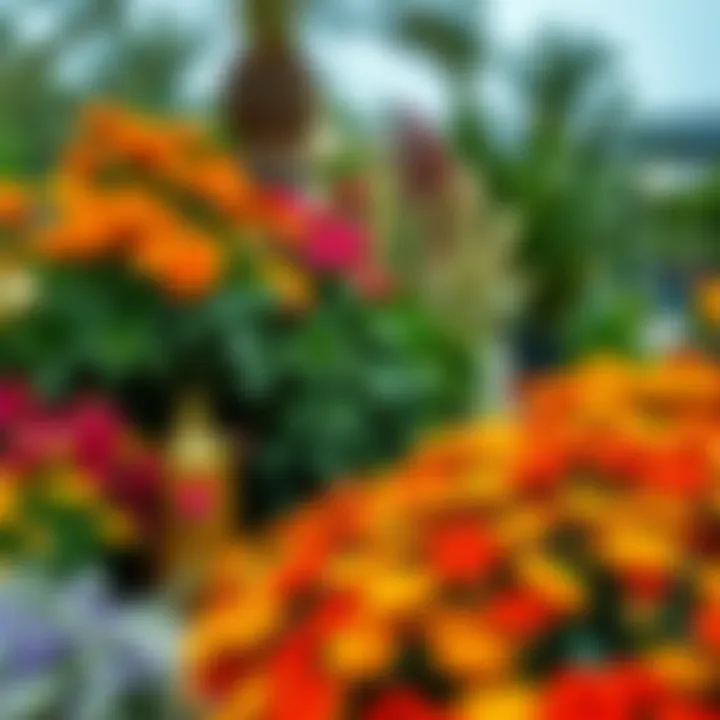
Intro
Dubai is often hailed as a beacon of modern architecture and luxurious living. Its skyline, marked by soaring towers, represents the familiar pulse of urban life. However, amid this concrete jungle, the city's gardens offer a refreshing juxtaposition. They are not merely patches of greenery; they embody the vision of a harmonious blend between urban development and nature.
With a myriad of gardens scattered throughout the city, each one tells its own unique story while contributing to the larger narrative of experiencing tranquility in a bustling metropolis. From the vibrant blooms of the Dubai Miracle Garden to the serene landscapes of Al Barsha Pond Park, these green spaces collectively enhance residents’ quality of life and draw visitors looking for a slice of nature away from the hustle and bustle.
This article will guide you through some of the most notable gardens in Dubai, highlighting their characteristics, the plant life that thrives in them, and their role in contributing to an ever-adapting urban ecosystem. Whether you’re a nature lover, a resident wanting a peaceful retreat or a traveler exploring new sights, understanding these gardens provides a fresh perspective on what Dubai has to offer.
The rich biodiversity in these spaces not only helps to improve air quality but also serves as urban habitats for various fauna. Therefore, delve deeper with us as we explore Dubai's gardens, illustrating how these verdant areas contribute significantly to ecological balance and community well-being.
Prolusion to Dubai's Green Spaces
Dubai, often known for its soaring skyscrapers and vibrant nightlife, may not be the first place that comes to mind when one thinks about lush gardens and green spaces. However, the significance of gardens in this bustling metropolis cannot be overlooked. These green havens serve multiple purposes; they are not merely aesthetic additions to the urban landscape but essential components of the city’s ecological and social fabric.
Significance of Gardens in Urban Settings
In urban environments like Dubai, gardens offer more than just beauty. They play a crucial role in improving air quality, reducing the urban heat island effect, and enhancing biodiversity. By introducing various plant species, these gardens create habitats that support local wildlife, from birds to insects. Furthermore, they provide residents and visitors a respite from the concrete jungle, encouraging outdoor activity and facilitating social interaction.
The gardens of Dubai can be seen as vital public assets that contribute directly to the well-being of its inhabitants. Through design and maintenance, these green spaces engage communities and promote a sense of ownership among residents. When citizens invest in their local parks and gardens, it fosters pride and strengthens social ties. Gardens often become venues for cultural events, markets, and community gatherings, making them integral to community building.
Dubai's Climate and Its Impact on Garden Design
Dubai's climate is marked by scorching temperatures and limited rainfall, which presents unique challenges for garden design. The arid conditions dictate that gardens in this city must prioritize drought-resistant plants and innovative irrigation techniques. Landscape architects and designers have to be adept at selecting flora that can thrive in such an environment while still offering visual appeal.
In this context, the use of native plants becomes crucial. Species that have adapted to the local climate not only survive but flourish, requiring less water and maintenance compared to non-native varieties. This has led to the integration of gardens that showcase not only ornamental beauty but also functional landscaping, promoting sustainability and conservation of resources.
Thus, Dubai’s gardens emerge as a testament to human ingenuity in harmonizing nature with urbanization. The delicate balance between maintaining environmental integrity while fostering an enjoyable space is rigorously considered at all stages of planning and execution. As a result, these green spaces not only beautify the city but also contribute significantly to its ecological sustainability.
The Dubai Miracle Garden: A Floral Wonderland
The Dubai Miracle Garden stands as a vibrant testament to the city's commitment to blending nature with innovation. Acting as a breath of fresh air in the midst of an urban landscape, this garden occupies a prominent place in Dubai's green narrative. With more than 150 million flowers arranged in various designs, it serves not only as an intricate escape for visitors but also as a showcase of sustainable practices and landscaping artistry. The importance of the Miracle Garden transcends its stunning visuals; it encourages an appreciation for biodiversity and cultivates a sense of community among its diverse visitors.
Key Attractions Within the Miracle Garden
The array of attractions within the Miracle Garden is astounding. As visitors weave through the pathways, they encounter thematic displays, each boasting thousands of blossoms in a riot of colors. Noteworthy attractions include:
- The Heart Tunnel: This exquisite display entices couples and families alike, as they stroll hand-in-hand through a canopy of blooming petals set in a heart shape. It’s like walking through a dream, and it proves to be a perfect backdrop for photographs.
- The Flower Clock: A unique blend of nature and engineering, the Flower Clock keeps accurate time while showcasing a stunning arrangement of various floral types. This specific installation not only appeals to aesthetics but serves a functional purpose, expressing the harmony between nature and human ingenuity.
- Air Balloon: Stretching high above the vibrant landscape, the hot air balloon offers panoramic views of the entire garden. Soaring above this floral wonder provides a stunning perspective, allowing visitors to immerse themselves in the colors and designs that animate the garden.
Each of these attractions communicates the garden's dedication to creativity and innovation, resulting in a truly unique floral experience. The sheer beauty of the garden invigorates the senses, leaving visitors with memories that are as vivid as the blossoms surrounding them.
Seasonal Highlights and Special Events
Throughout the year, the Miracle Garden takes on different personalities, particularly during seasonal events that revitalize its floral canvas. Each season introduces new designs and themes, ensuring that each visit offers something fresh and exciting.
The popular Spring Festival is one such event that draws crowds from all over the world. This festival showcases not only the blooms but also local artists and musicians, creating a lively atmosphere filled with culture and creativity. Participating in workshops like flower arrangement sessions allows visitors to engage directly with nature and artistic expression.
In addition, the garden celebrates holiday festivities with themed decorations and events, such as elaborate setups for Valentine's Day or Eid. For instance, during Valentine's Day, heart-shaped configurations and romantic settings emerge, catering to couples seeking a picturesque escape. With dazzling illumination during the evening hours, the garden transforms into a captivating spectacle that enchants visitors long after the sun sets.
The Miracle Garden is not just a place to admire flowers; it's a thriving display of art, community spirit, and environmental awareness, making it an essential feature of Dubai’s rich landscape.
Overall, the Dubai Miracle Garden functions as a unique floral wonderland that encapsulates the heart of nature amidst a bustling metropolis. Each attraction and event reflects a commitment to innovation, community engagement, and the importance of sustainable practices in enhancing urban living.
Al Barsha Pond Park: A Community Hub
Al Barsha Pond Park stands as a vital point of community interaction and relaxation amidst the urban sprawl of Dubai. This park is not just a patch of greenery; it is a thriving ecosystem that serves the dual purpose of offering a sanctuary to its visitors and enhancing the ecological footprint of the city. Strategically located, it caters to the diverse interests of the local populace as well as tourists, making it an essential stop for those exploring the city’s green spaces.
Facilities and Amenities Available
Within the boundaries of Al Barsha Pond Park, visitors can find an impressive array of facilities that cater to various recreational needs.
- Walking and Jogging Tracks: A well-maintained track surrounds the pond, encouraging fitness enthusiasts to engage in walking or jogging, all while enjoying panoramic views of the water.
- Bicycle Paths: The park offers dedicated bicycle lanes for those who prefer pedaling through the lush scenery. It’s a delightful way to spend the day with family or friends.
- Children’s Play Areas: Safety is a priority here, with multiple play zones designed for kids of all ages. These areas are filled with modern equipment, ensuring children can play safely while parents watch with ease.
- Leisure Facilities: Picnic spots dotted around allow families to enjoy a meal al fresco. Additionally, there are benches and shaded areas ideal for relaxation.
- Open Green Spaces: The vast lawns are not only aesthetically pleasing but also serve as spots for informal gatherings or events.
Each of these amenities enhances the user experience, encouraging a blend of exercise, family bonding, and social interaction. Aside from functional aspects, the park emits a serene ambiance, vital for reducing stress in our fast-paced lives.
Activities for Families and Visitors
Al Barsha Pond Park is a hub of activities that invites visitors to engage with nature and each other in meaningful ways. Whether you're a local or just passing through, there’s something for everyone:
- Fitness Programs: Regular yoga classes and fitness groups often meet in the mornings, drawing health-conscious individuals looking to unwind while getting in shape.
- Bird Watching: The park attracts various bird species, making it a favorite spot for bird watchers. Binoculars are a recommended accessory for catching glimpses of some rare sights.
- Cultural Events: Seasonal festivals and community gatherings enliven the park’s atmosphere. These events often showcase local artists and promote cultural exchange, inviting everyone to participate and celebrate.
- Family Days: Specific days in the month are dedicated to family engagements with games, competitions, and workshops that educate children about nature.
The presence of such activities enhances social cohesion within the community, turning Al Barsha Pond Park into more than just a park; it fosters a sense of belonging among its users.
With the atmosphere filled with laughter and shared experiences, Al Barsha Pond Park remains a quintessential element of Dubai’s commitment to providing green spaces for community well-being and environmental sustainability.
Dubai Garden Glow: A Unique Nighttime Experience
Dubai Garden Glow stands out as a beacon of creativity and innovation in the lush landscape of Dubai's gardens. This enchanting venue combines art and nature, creating a one-of-a-kind experience after sunset where the city’s vibrant energy meets a canvas of light and color. Visitors find themselves immersed in a world adorned with captivating displays that transform the garden into a fantastical realm. The importance of this attraction lies not only in its visual appeal but also in its role as a social and cultural hub, drawing both locals and tourists to celebrate art, wildlife, and sustainability.
Art Installations and Illumination Displays
At the heart of Dubai Garden Glow are its spectacular art installations and illumination displays, which create an ethereal atmosphere that lingers in one's memory long after the visit. The artworks, crafted from a variety of light materials, depict a dazzling array of themes, from whimsical interpretations of wildlife to striking representations of cultural symbols. The signature attraction, known as "Glow Park," features glowing sculptures made from sustainable materials that radiate dazzling colors, inviting exploration and sparking wonder.
Visitors often journey through various sections of the garden, each offering a distinct theme that captures the imagination:
- Wildlife, represented through lifelike representations of animals, adds a playful yet educational aspect.
- Cultural Exhibits, showcasing Dubai's rich heritage, highlight the merging of tradition and modernity.
- Interactive exhibits, where visitors can engage with the art, make the experience more personal and memorable.
Visitors are encouraged to stroll through the garden leisurely, taking in the seasonal displays that change yearly, making each visit uniquely special.
Such displays are not mere decorative additions; they make strong statements about the beauty and fragility of the natural world. Every installation prompts viewers to think deeper about their impact on the planet while providing a sensory feast that delights both eye and spirit.
Integration of Sustainable Practices
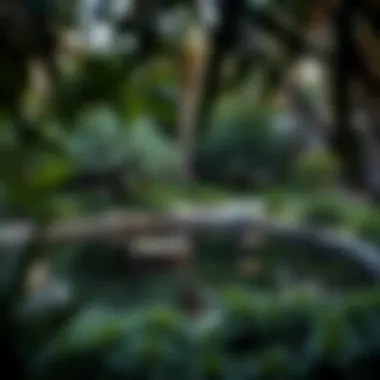
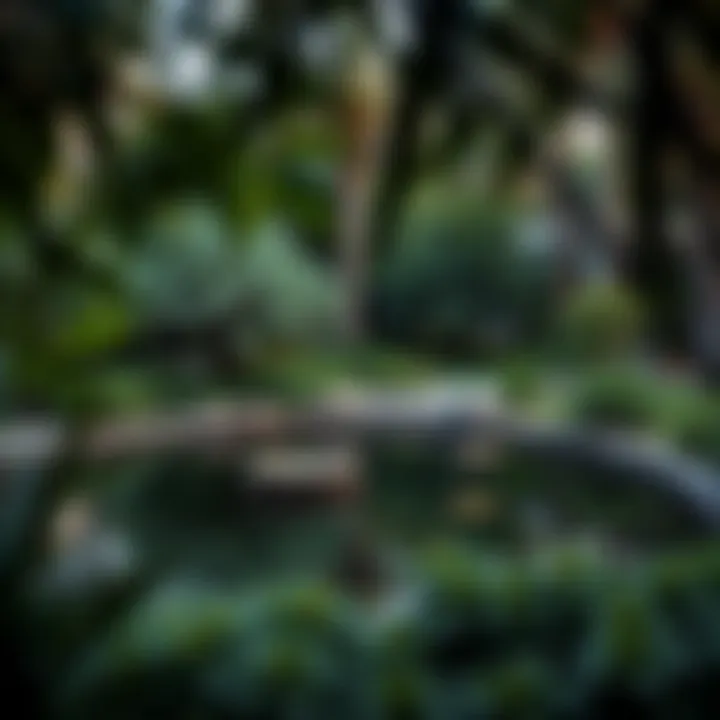
Sustainability is a crucial theme woven into the fabric of Dubai Garden Glow. The garden employs innovative approaches to artificial lighting, using energy-efficient technologies that reduce the environmental footprint of what could otherwise be a resource-intensive endeavor. From the construction materials utilized in the art installations to the management of the garden’s environmental policies, every aspect considers its broader ecological implications.
“The fusion of art with sustainability serves not just to inspire awe, but also to educate visitors on the importance of responsible environmental stewardship.”
Key sustainable practices include:
- Use of Recycled Materials: Many sculptures use upcycled items, transforming waste into artful expressions that not only showcase creativity but also promote recycling.
- Water Conservation: The garden employs water-efficient systems for irrigation, ensuring that the plants thrive without straining local water resources.
- Energy Management: Solar-powered lights provide ambiance while minimizing dependence on conventional energy sources; this not only saves costs but also sets an example for sustainable tourism.
Dubai Garden Glow thus stands as a symbol of the blend between modern art and ecological responsibility, illustrating how festivals and attractions can celebrate both creativity and sustainability. With every visit, guests not only witness the beauty but also contribute to an ongoing dialogue about preserving the environment for future generations.
The Green Planet: An Indoor Rainforest
The Green Planet stands as a testament to Dubai's commitment to blending nature with urban living. Tucked away in the City Walk area, this unique indoor rainforest draws visitors into a lush environment that feels worlds apart from the surrounding cityscape. This space is more than just an attraction—it's a vital piece of the puzzle in understanding biodiversity and ecological awareness in an urban setting.
Biodiversity and Ecosystem Insights
The principles of biodiversity are brilliantly showcased within The Green Planet. Housing over 3,000 flora and fauna species, including exotic birds and reptiles, this indoor ecosystem emulates a tropical rainforest environment. Visitors can wander through layers of vegetation that mimic the distinct strata found in natural forests. From the dense canopy to the forest floor, every nook reveals interconnected ecosystems that highlight the importance of biodiversity.
- Native and Non-Native Species: Among the exhibits, guests will find a mix of native plants, such as the iconic date palm, perfectly mixed with tropical species like the striking Brazilian nut tree. This blending promotes discussions about sustainability and conservation, particularly how various ecosystems can thrive together in harmony, even in a city like Dubai.
- Delicate Eco-Balance: The intricate interactions between plants and animals serve as a living example of how ecosystems sustain themselves. Each species plays a role, contributing to a balanced environment that helps in educating the public on the fragility of ecosystems and what can be done to preserve them.
"Understanding biodiversity is crucial. It helps us realize the delicate balance in our ecosystems and the impact of each species on our environment."
Visitor Engagement and Educational Programs
The Green Planet not only showcases biodiversity but also engages its visitors through thoughtful educational programs. These programs emphasize the importance of environmental stewardship and sustainability.
- Guided Tours and Workshops: Regular guided tours offer deep dives into the relationships between species present, the roles they play, and conservation efforts. Hands-on workshops allow for deeper learning experiences—activities such as planting seeds from various species and understanding how to care for them.
- Interactive Exhibit Zones: Zones, like the Rainforest Corner, allow for immersive experiences where visitors can touch, hear, and see the elements of a rainforest. Sounds of chirping birds and flowing water create an enchanting ambiance, pulling guests further into the natural world.
- Special Programs for Schools: Designed with local educational institutions in mind, school programs are structured to align with curriculums. Students learn about biological sciences in a captivating way that textbooks often struggle to replicate.
Integrating nature more fully into urban settings isn't just a luxury; it's a necessity for future generations. As more visitors experience The Green Planet, they develop a deeper appreciation for nature, raising the likelihood that they’ll advocate for conservation in their communities. By fostering this connection, the attraction aims to inspire positive change in attendees long after they leave its verdant embrace.
Dubai Marina Walk: Nature Meets Urban Life
The Dubai Marina Walk exemplifies the fusion of urban living and nature, creating a harmonious escape for residents and visitors alike. It's more than just a pedestrian promenade; it's a vibrant hub that showcases the beauty of Dubai's waterfront while offering a respite from the bustling city life. This walk is thoughtfully designed, providing not only stunning views of the marina but also a tranquil atmosphere that invites people to slow down and appreciate their surroundings. In this bustling metropolis, Dubai Marina Walk serves as a testament to how urban spaces can incorporate greenery and water features, reshaping the experience of city living.
Landscape Features and Architectural Harmony
One cannot overlook the impressive landscape features that define Dubai Marina Walk. The walkway sprawls alongside the glittering waters of the Marina, flanked by lush greenery and lined with palm trees that sway gently in the breeze. What's truly remarkable is the integration of nature with modern architecture. Sleek high-rise buildings, many adorned with balconies filled with greenery or vertical gardens, create a stunning backdrop to this picturesque setting. The blend of natural elements and contemporary design contributes to a charming aesthetic that captures the essence of Dubai's luxurious lifestyle without compromising on its connection to the environment.
Grassy patches invite picnics, while shaded seating areas provide perfect spots for relaxation or conversation. Pathways are well-maintained, allowing for an enjoyable stroll whether in the heat of the day or under the twinkling stars at night. The careful planning and consideration that went into the landscape and architectural harmony illustrate a thoughtful approach, prioritizing well-being and visual appeal in a usually fast-paced urban space.
Dining and Leisure Opportunities Along the Walk
As if the scenic views weren't enough, Dubai Marina Walk hosts an array of dining and leisure options that cater to a diverse audience. The waterfront is dotted with a mix of casual cafés, fine dining establishments, and international cuisine, allowing visitors to savor culinary delights while overlooking the glistening waters. Whether one craves sushi at SushiArt or an Italian feast at Pizzeria Mozza, options abound, ensuring every palate is satisfied.
Beyond dining, the area is also a hotspot for leisure activities. You can rent bikes to cycle along the promenade or simply meander through boutique shops that line the walkway. Families find enjoyment at children's play areas scattered along the route, encouraging laughter and fun in a safe, green environment.
Moreover, numerous events take place along the Marina Walk throughout the year, from food festivals to outdoor movie nights. These gatherings foster a sense of community, inviting individuals to connect and share in the joyous ambiance of the Marina.
"The Marina Walk is not only a place for leisure; it embodies a lifestyle that embraces both community and nature within urban settings."
In summary, the Dubai Marina Walk serves as an important example of how urban spaces can effectively balance nature and modernity. It offers a template for future developments that prioritize green spaces, sustainable practices, and community engagement. Residents and visitors alike find not only a scenic escape here but also a deeper appreciation for the thoughtful integration of ecological elements into the fabric of urban life.
Ras Al Khor Wildlife Sanctuary: A Conservation Area
Ras Al Khor Wildlife Sanctuary stands as a vital green heartbeat within the bustling city of Dubai. Spanning across 6.2 square kilometers, this sanctuary is remarkably significant not just for the local ecosystem but also for providing a vital refuge for various species wind-through it. It serves as a prime example of how urban areas can integrate and preserve nature amidst rapid development.
Importance of the Sanctuary to Local Wildlife
This sanctuary is home to over 450 species of wildlife, ranging from various birds to other forms of fauna. Notably, Ras Al Khor is a breeding ground for migratory birds, including the magnificent greater flamingo, which has become a symbol of the sanctuary. Each winter, between October and April, thousands of these vibrant birds flock to the area, creating a breathtaking spectacle that attracts nature enthusiasts and photographers alike.
The sanctuary plays a crucial role in maintaining the ecological balance within the region. By acting as a natural filter for pollution and providing habitats for wildlife, the wetland ecosystem contributes significantly to the health of local biodiversity.
In addition to birds, the sanctuary is home to various aquatic life, which helps in sustaining the food chain within this unique ecosystem. It is an excellent reminder of how even in an urban setting, wildlife can find a place to thrive, offering a glimpse into nature's resilience.
Ecotourism and Visitor Accessibility
Ras Al Khor Wildlife Sanctuary stands as a beacon for ecotourism, emphasizing the importance of responsible wildlife observation. The sanctuary provides well-maintained visitor centers and several observation points equipped with telescopes, allowing guests to enjoy the wildlife without disturbing their natural habitats. These facilities are designed to support educational initiatives on the importance of wildlife conservation.
Visitors to the sanctuary can also engage in numerous activities - from guided tours to bird-watching programs.
Key points about visitor accessibility include:
- Free Entry: The sanctuary offers free access, making it a popular destination for families and tourists.
- Guided Tours: Educational tours are available to deepen understanding of the local wildlife and ecology.
- Photographic Opportunities: The scenic landscapes and diverse wildlife offer exceptional opportunities for photographers, be they amateurs or professionals.
"A visit to Ras Al Khor reminds us that amidst the steel and glass, nature finds a way to thrive and enchant."
Safa Park: A Popular Urban Escape
Safa Park stands out as one of Dubai’s cherished urban oases, offering residents and visitors alike a refreshing respite from the city's fast-paced lifestyle. This park isn’t just a patch of green; it is a carefully designed landscape incorporating various recreational facilities, green spaces, and cultural elements that make it a focal point for community engagement.
Recreational Facilities and Open Spaces
The heart of Safa Park lies in its array of recreational facilities, catering to individuals and families. The park features expansive lawns where children can run freely and play games, and well-maintained jogging tracks for fitness enthusiasts. Moreover, you can find serene walking paths framed by trees, providing an ideal setting for a leisurely stroll or a brisk walk alike.
Facilities Include:
- Children’s Play Areas: With climbing frames and swings, these designated spots promote active play while ensuring safety.
- Picnic Areas: Tables and benches scattered throughout the park make it easy to enjoy a meal outdoors, creating opportunities for families to bond and friends to catch up.
- Fitness Stations: Strategically placed exercise equipment allows park-goers to maintain their fitness regime while surrounded by lush greenery.
- Water Features: Beautifully designed ponds enhance the park's visual appeal and provide habitats for various bird species.
These facilities turn Safa Park into a hub for physical activity and social interaction. The design encourages a lifestyle that integrates wellness and relaxation, highlighting the importance of nature in urban environments.
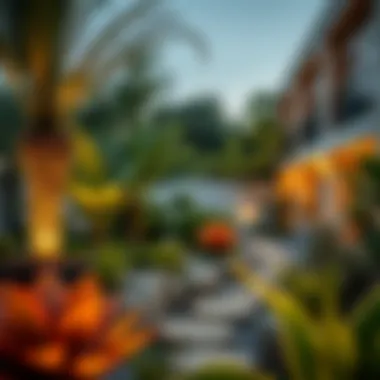
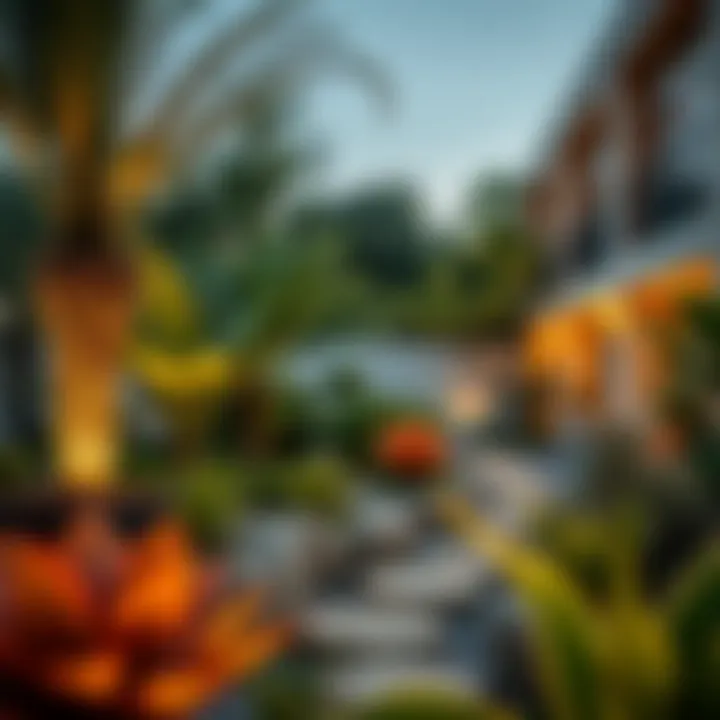
Cultural Events and Community Gatherings
Safa Park is more than just a recreational space; it serves as a cultural epicenter for the Dubai community. Throughout the year, the park hosts numerous cultural events, festivals, and gatherings that foster community spirit and celebrate diversity.
Notable Events Include:
- Art Exhibitions: Local artists often showcase their work, turning the park into a canvas for creativity, attracting art lovers from all over.
- Seasonal Festivals: From the Dubai Shopping Festival activities to National Day celebrations, these events bring together people of various backgrounds, making it a melting pot of cultures.
- Community Fitness Events: Yoga sessions and fun runs are organized regularly, promoting health and wellness while creating camaraderie among participants.
Zabeel Park: A Technological Marvel
Zabeel Park stands as one of Dubai's most technologically advanced green spaces, showcasing how innovative designs can merge seamlessly with nature. This park is not just a place to relax; it’s also a testament to progress in urban planning and environmental engineering. With its strategic location between Sheikh Zayed Road and the Dubai World Trade Centre, it serves as a vital green lung in the bustling city.
The importance of Zabeel Park cannot be overstated. It offers a unique blend of recreation, technology, and environmental consciousness, making it a quintessential example of how urban landscapes can be both functional and aesthetically pleasing. It caters to the needs of various demographics, from families seeking leisurely day outings to tech enthusiasts fascinated by its integrated features.
Innovative Features and Attractions
Zabeel Park is dotted with numerous attractions that enhance visitor experiences. One of its most notable features is the Dubai Frame, a structure that provides stunning views of both old and new Dubai. Here are some additional highlights:
- Interactive Displays: The park is equipped with modern touchscreen kiosks that provide information about the park’s facilities and events.
- Wi-Fi Availability: Free Wi-Fi allows visitors to stay connected while enjoying the natural beauty around them.
- Smart Waste Management: The park employs smart bins that compact waste and notify management when they need to be emptied, optimizing maintenance efforts.
- Themed Gardens: Various sections highlight different themes, including botanical gardens showcasing native flora and educational parks for children to learn about ecology.
With event spaces for music concerts, fitness classes, and cultural festivals, Zabeel Park continuously engages the community.
Technological Integration in Landscaping
The landscaping of Zabeel Park reflects a pioneering attitude towards environmental sustainability and urban greening.
- Drip Irrigation Systems: Using advanced drip irrigation techniques significantly conserves water, ensuring that the park remains lush even in Dubai's arid climate.
- Solar-Powered Facilities: Energy-efficient lighting and facilities powered by solar panels reduce the park's carbon footprint and inspire similar practices across the city.
- Smart Planting Techniques: The choice of plant species in the park prioritizes native flora, which requires less water and is adaptable to local conditions, promoting biodiversity.
Visitors can also appreciate how the park effectively utilizes vertical gardens and green walls, enhancing aesthetic appeal while improving air quality.
Zabeel Park, through its technological marvel and innovative features, sets a precedent for future parks in urban environments. It exemplifies how thoughtful design integrated with technology can create spaces that cater to the modern-day community while respecting the surrounding natural ecosystem.
"Zabeel Park not only provides a space for recreation but also serves as a model for sustainable urban landscaping in cities worldwide."
For more information about Zabeel Park, you can visit Dubai's official tourism website and explore their dedicated page for detailed features, attractions, and upcoming events.
The Sustainable City: A Model for Eco-Friendly Living
Dubai's ambition to establish itself as a leading sustainable city has led to the development of innovative landscapes that harmoniously blend nature and urban living. This emphasis on sustainability is not merely about aesthetic grounds; it is a pivotal criterion for enhancing quality of life and addressing environmental challenges. Through eco-friendly practices and community engagement, Dubai aims to set a precedent worldwide, proving that rapid urban development does not have to come at the expense of its natural surroundings.
Sustainable Practices in Landscaping
The foundation of a sustainable city largely rests on its landscaping practices. One stand-out feature in Dubai’s approach is the incorporation of native plants into public and private gardens. Native flora are vital as they require less water and are more resilient to the local climate. By choosing plants such as the ghaf tree or date palm, gardens can thrive while minimizing water usage, crucial in a desert environment.
Moreover, the implementation of permeable surfaces in parks and gardens enables better rainwater management. These surfaces allow for the absorption of rainfall, reducing runoff and promoting groundwater recharge. This is especially important considering Dubai’s unpredictable rain patterns. Additionally, the use of xeriscaping—landscaping designed to reduce or eliminate the need for irrigation—has gained traction as a preferred methodology that emphasizes sustainability.
"With every green initiative, we not only beautify our city but also contribute to a healthier planet."
Furthermore, technology plays a pivotal role. Smart irrigation systems that utilize weather data to optimize watering schedules ensure that each droplet counts. This not only alleviates water waste but also designs a more efficient urban environment that nurtures greenery without neglecting critical resources.
Community Initiatives and Green Spaces
The success of a sustainable city relies heavily on community involvement and ownership. In Dubai, initiatives that promote the development of green spaces have brought residents together, fostering a sense of collective responsibility toward environmental stewardship.
Local organizations frequently engage in tree planting events, creating enthusiasm and participation among residents. This hands-on approach instills pride and awareness about nature's importance within urban settings. These initiatives are vital, as they help develop urban forests which contribute to better air quality and a varied ecosystem within the city.
Moreover, community gardens have taken root in various neighborhoods, offering residents a place to grow their own produce and connect with like-minded individuals. This not only provides fresh food options but also strengthens neighborhood ties, resulting in a safer, more cohesive community.
Some notable initiatives aiming to enhance greenery include awareness campaigns highlighting the ecological importance of native species and sustainability workshops educating residents on home gardening techniques that can minimize environmental impact.
Al Khazzan Park: A Hidden Gem
Al Khazzan Park, nestled between the bustling areas of Dubai, often flies under the radar compared to the city's more famous green spots. However, this park serves as a tranquil sanctuary, catering to those who seek solace from the urban hustle. Its significance lies not only in its aesthetic appeal but also in the holistic experience it offers to both residents and visitors. As urban living often lacks natural spaces, Al Khazzan Park is a breath of fresh air, presenting an opportunity for relaxation, exercise, and community engagement.
Overview of Facilities and Attractions
The park features carefully curated facilities that cater to all ages and interests. Key attractions include:
- Walking and Jogging Tracks: Well-maintained paths encourage physical activity amidst a lush environment. These tracks offer gentle sights of local flora, making exercise feel less like a chore and more like a leisurely stroll through nature.
- Play Areas for Children: Tailored for the little ones, the play areas provide safe equipment to foster play and interaction. Swings, slides, and climbing structures are scattered in shaded spots, encouraging children to enjoy outside time.
- Picnic Areas: Several open spaces are dotted with picnic tables and benches. Families and friends can gather here for a meal under the sun or the shade of trees, creating a community vibe.
- Seating Areas with Scenic Views: The park offers comfortable seating options throughout. Visitors can unwind while enjoying serene views of the well-kept greenery around.
"Al Khazzan Park isn’t just a space; it’s a community lifeline where nature meets camaraderie."
Each of these facilities comes together to create a multifaceted green space that encourages both activity and relaxation, making it one of the charming, lesser-known spots in Dubai.
Cultural Significance and Community Involvement
Al Khazzan Park plays a pivotal role in fostering community involvement. Its design encourages social interactions and cultural exchanges, making it more than just a park. Residents actively participate in various activities, such as:
- Community Events: The park often hosts cultural events that draw people together. These gatherings promote local traditions, allowing both Emiratis and expatriates to share in the experience. Activities might include outdoor movie nights or craft fairs.
- Environmental Initiatives: Local volunteers support the maintenance of the park through cleanup activities and tree planting initiatives. This not only fosters a sense of ownership among residents but also teaches valuable lessons about conservation.
- Cultural Exchange Programs: Al Khazzan hosts workshops and educational programs designed to immerse participants in the cultural richness of the UAE. Such initiatives help to build bridges across various community groups and foster understanding.
The involvement of the community in the park's upkeep and activities shows that Al Khazzan Park is not merely a place for leisure but a social hub that binds the community together. As more people recognize its value, there is a growing appreciation for its role in promoting sustainable urban living in Dubai.
Dubai Aquarium and Underwater Zoo: A Fascinating Experience
The Dubai Aquarium and Underwater Zoo is a remarkable destination nestled within the bustling Dubai Mall. It stands as a testament to the city’s commitment to showcasing the marvels of marine life while promoting environmental awareness. This attraction doesn’t just serve as a feast for the eyes; it plays a significant role in educating the public about aquatic ecosystems and the importance of conservation.
Aquatic Displays and Environmental Education
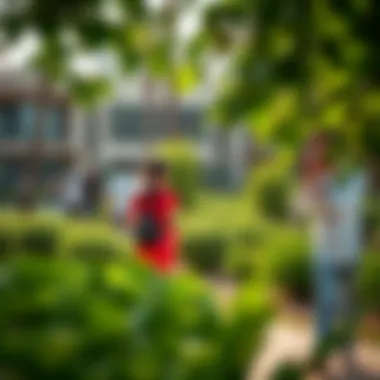
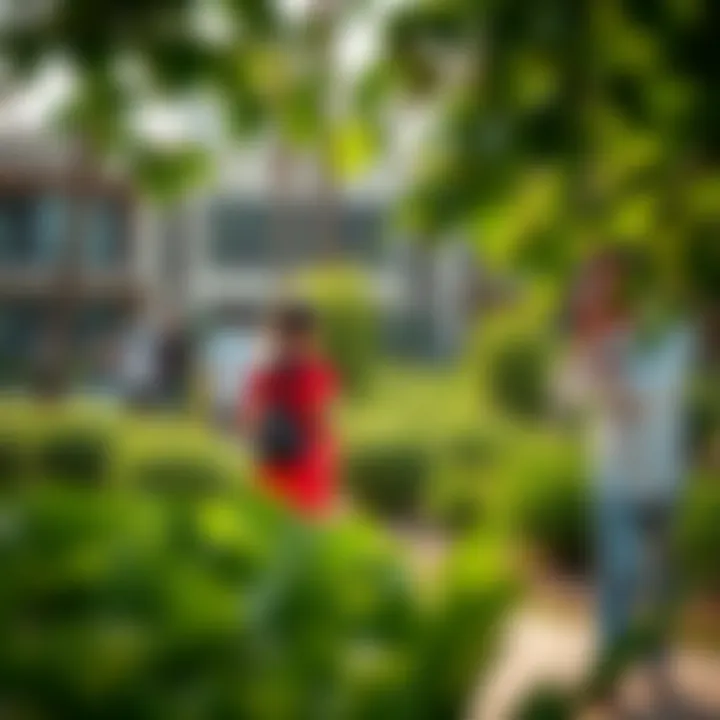
Stepping into the aquarium is like diving into another world. With its massive acrylic panel, one can gaze at a diverse array of marine species, from the graceful rays swimming leisurely to the striking sharks gliding by. Visitors are treated to an experience that is as much about learning as it is about leisure. Signage throughout the aquarium explains the various species on display, including their habitats and roles in the ecosystem.
Interactive exhibits further enhance this educational journey. Children and adults alike engage with information about how each creature contributes to the aquatic food chain.
The aquarium hosts regular talks and demonstrations. These events focus on issues such as sustainable fishing and the impact of pollution on marine life. By illuminating these pressing concerns, the aquarium aims to foster a sense of responsibility towards preserving our oceans.
"Education about marine life is crucial. An aware public leads to effective conservation practices."
Conservation Efforts and Awareness Programs
The aquarium is not just about showcasing fish in a glass tank; it actively participates in conservation efforts, both locally and globally. Programs designed to rehabilitate injured sea creatures exemplify this commitment. The facility collaborates with various organizations to rescue and rehabilitate marine animals, ensuring that they can return to their natural habitats when possible.
Additionally, the Dubai Aquarium runs numerous awareness initiatives. For example, the aquarium hosts workshops to educate both tourists and residents about the importance of sustainable practices. These sessions often cover topics such as reducing plastic usage and understanding the impacts of ocean pollution.
Moreover, by partnering with local schools, the aquarium provides students with hands-on learning experiences. Field trips allow students to witness marine life firsthand and understand the delicate balance of the ecosystem.
The Role of Gardens in Enhancing Urban Biodiversity
Urban gardens are not just pretty patches of green; they're essential players in enhancing biodiversity across city landscapes. In an environment where concrete can dominate, gardens serve as crucial habitats for a variety of species. They provide sanctuaries for flora and fauna, offering connectivity amid the urban sprawl. Beyond adding aesthetic value, gardens can influence local ecosystems significantly. Here’s how they do it.
Gardens create microhabitats that support not only plants but also insects, birds, and small mammals. For example, imagine a garden teeming with native plants. These plants are adapted to the local environment and climate. They offer food resources for local insects which, in turn, attract birds and other wildlife. The intricate web of relationships among these species helps maintain a balanced ecosystem, even in heavily developed areas.
"In the concrete jungle, it’s the gardens that provide us a glimpse into nature’s resilience and adaptability."
Native Plants and Their Importance
The significance of native plants cannot be overstated. By integrating them into urban gardens, we align our gardening efforts with nature’s existing ecosystem. Native plants are like the unsung heroes of biodiversity conservation. They require less water and maintenance compared to exotic species, which often struggle to adapt. Furthermore, they bolster local wildlife. Pollinators, such as bees and butterflies, rely on these plants for sustenance.
A few key benefits of using native plants in gardens include:
- Natural Resilience: They are better suited to cope with local pests and diseases.
- Less Resource-Intensive: Lower water and fertilizer needs help conserve resources.
- Support for Local Wildlife: These plants provide shelter and food sources for many species, increasing biodiversity.
Strategies for Biodiversity Conservation in Urban Areas
Maintaining urban biodiversity requires thoughtful strategies. As more people flock to cities, the challenge is finding a balance between development and nature.
Here are some effective methods to foster biodiversity through urban gardening:
- Create Green Corridors: Establish pathways of green spaces that connect different habitats to allow wildlife to flourish. These corridors can be parks, green roofs, or even tree-lined streets.
- Implement Rain Gardens: These gardens can help manage stormwater runoff, while naturally filtering pollutants and providing habitats for native species.
- Encourage Community Gardens: Engaging residents in planting native species creates a sense of ownership and further enriches the local ecosystem.
- Promote Education and Awareness: Community workshops on the importance of biodiversity can empower residents to make informed choices in their gardening practices.
- Utilize Vertical Gardens: Facades adorned with plants can increase green cover in crowded cities, bringing nature closer to residential areas.
Incorporating these strategies can lead to a significant increase in biodiversity in urban centers. As cities continue to expand, the role of gardens in creating livable, sustainable environments is increasingly urgent. By prioritizing the planting of native species and employing innovative gardening approaches, Dubai can contribute to a healthier urban biodiversity, paving the way for future generations to appreciate and enjoy the natural world.
Future of Green Spaces in Dubai
The future of green spaces in Dubai isn't just a nice-to-have; it's crucial. As the city expands and modernizes, the necessity for pockets of greenery becomes increasingly evident. These green areas provide not only a refuge from the hustle and bustle of city life but also play a significant role in improving air quality, enhancing biodiversity, and fostering community well-being. The intricate balance between urbanization and environmental sustainability will define how Dubai's landscape evolves in the upcoming years.
Urban Planning and Green Infrastructure
Urban planning in Dubai is gradually shifting its focus. Meanwhile, proactive measures are being taken to incorporate green infrastructure into the city's fabric. This shift is not just about parks but includes green roofs, vertical gardens, and permeable pavements, which help manage stormwater and reduce urban heat.
Some key aspects of integrating green spaces into urban planning are:
- Promoting Biodiversity: Incorporating native plant species helps create a habitat for local wildlife, which is vital for maintaining ecological balance.
- Enhancing Public Health: Access to nature can improve mental and physical health, reducing healthcare costs for the city in the long run.
- Economic Benefits: Attractive green spaces can boost property values and attract tourists, contributing to the local economy.
As architects and planners rethink the landscape, Dubai aims to position itself as a pioneer in sustainable urban living. This evolves not only the aesthetics but also improves livability for all residents.
Community Participation and Ownership
Community involvement is essential for the success and sustainability of green spaces in Dubai. When residents take an active role in the design and maintenance of their local parks, the connection to these spaces deepens.
Consider these important elements:
- Local Input: Encouraging community feedback during the planning stages ensures that the gardens meet the needs and desires of the people who use them.
- Volunteer Programs: Programs that engage residents in hands-on activities like tree planting and gardening instill a sense of ownership and responsibility toward the green spaces.
- Educational Outreach: Workshops aimed at teaching sustainable practices can empower residents. This kind of engagement helps people appreciate and protect their local environments.
Ultimately, sustainable green spaces are built not just by planners but with the heart of the community driving their development. This grassroots support can transform the scenery, linking citizens to nature right in the heart of the bustling city.
"Green spaces represent a bridge between nature and the urban landscape, emphasizing that a city’s heartbeat is linked with its environment."
As Dubai strides into the future, fostering a closer relationship between the community and its gardens will not only enhance feelings of connection and well-being among residents, but it will also signify a conscious effort to embrace a greener, healthier urban environment.
End: The Vital Role of Gardens
The importance of gardens in Dubai's urban landscape cannot be overstated. As the city continues to grow rapidly, these green spaces have become vital not just for aesthetics but also for environmental health and community wellbeing. They serve as critical havens where city dwellers can momentarily escape the hustle and bustle of Dubai's ever-busy streets, taking a deep breath of the fresh air that these gardens help to produce.
Gardens foster connections among residents, providing communal areas where social interactions can flourish. Such spaces allow people to gather, share experiences, and participate in community-focused events, which strengthens the social fabric of the city. From children playing to families enjoying picnics, these vibrant green spots spark life in what might otherwise be an overly corporate and industrial environment.
Moreover, gardens play a significant role in promoting biodiversity. They provide habitats for various plant and animal species, contributing to a more balanced ecosystem. The introduction of native plants enhances the local flora, helping to sustain wildlife and promote ecological resilience. By creating gardens rich in diverse species, Dubai takes steps towards enhancing its urban biodiversity, reminding us that even in the heart of a bustling metropolis, nature has a place.
"Cities don’t need to be wholly concrete jungles; gardens bridge the gap between urban living and nature."
Integrating Nature into Urban Life
Integrating nature into urban life means more than just having parks; it's about fostering a sense of responsibility towards our living environment. The gardens in Dubai achieve this through careful design and thoughtful planning. They embrace native flora, creating landscapes that reflect the local climate while maximizing resource sustainability.
One standout example is the Dubai Miracle Garden, which showcases how urban gardens can transform a city. This spectacular site is an embodiment of creativity and nature harmoniously coexisting. While offering beauty, it simultaneously highlights the importance of environmental stewardship and the significance of reconnecting urbanites with nature.
Incorporating gardens into daily urban life also encourages residents to rethink their interaction with the environment. People become more acquainted with local wildlife, understand seasonal cycles, and develop a deeper appreciation for the ecological processes that support life.
Encouraging Sustainable Development Practices
Sustainable development practices are the backbone of ensuring that gardens continue to flourish in Dubai's evolving landscape. This means that while the city expands and urbanizes, the approach towards gardens remains centered on environmentally friendly practices. The role of public and private partnerships in fostering this shift is crucial. For instance, initiatives that incentivize the use of drought-resistant plants and landscape designs are essential not just for conservation but also for reducing the city's overall ecological footprint.
Gardens can be equipped with smart technology that monitors water usage, soil quality, and plant health. These innovations exemplify sustainability in practice and serve as benchmarks for future developments. Encouraging a culture of sustainability inspires collective efforts amongst residents, policymakers, and businesses, creating a roadmap for better urban living.
Ultimately, as investors, homeowners, and urban planners focus on the potential housed within these gardens, the emphasis will be on crafting environments that not only cater to human comfort but also accommodate wildlife and biodiversity. The result is a city where nature and urban life are not mutually exclusive but are integrally connected, each enriching the other.











